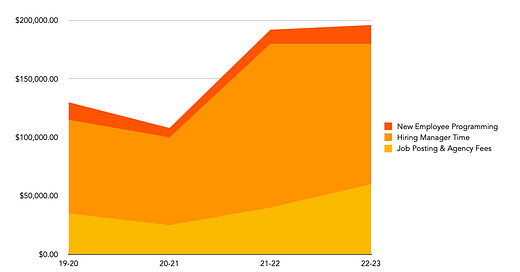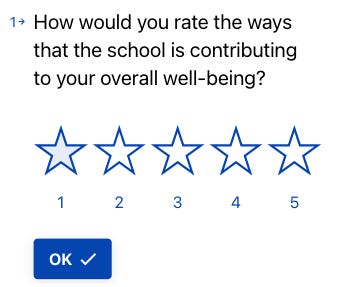The Brief Case 📚→💼→📈→📊
“How we are at the small scale is how we are at the large scale.”
—adrienne maree brown, Emergent Strategy: Shaping Change, Changing Worlds
We know only one thing for certain as we move through each school year: challenges, unplanned events, and interruptions will test the resilience — sometimes even the health — of school personnel.
Combine that with the record number of teachers leaving the field, the “quiet quitting” phenomena nipping at the psyche of even the most robust workforces, and the ever present need to outperform expectations in order to justify exorbitant tuition prices, and the case for faculty well-being hardly needs to be made.
We will make it anyway, looking to do so in ways that debunk some existing practices or assumptions. To begin, a bracing metaphor: faculty well-being is the air flowing through our hallways, invisible and taken for granted until the hallways are smoke-filled. Noticing it and shaping it for the better before a match is lit requires a consistent, sometimes conspicuous focus.
According to Gallup, a global analytics and advice firm that helps leaders and organizations solve their most pressing problems, “Work should be a stabilizing force in people’s lives. This is particularly true in psychologically brutal times like those the world experienced in 2020.”
Even when not dealing with 2020 levels of difficulty, school leaders should acknowledge the role that their schools play in the lives of their faculty members. When people are tired or frustrated or unable to find sanctuary at work to escape the unpredictability, irrationality, and sporadic cruelty of the outside world, their well-being is at risk. The same holds true if things inside an organization seem just as chaotic, reactive, or challenging as someone’s home, personal, or non-work life.
Once well-being starts to slip for even a few colleagues, it can carry morale and then performance down with it. As a school leader, getting your house in order — offering consistency, predictability, equanimity, and equitability — can prevent such slippage. Your faculty will excel, in part, when they feel well; when they know what to expect; when effort is calibrated with a worthy mission.
School can be a place that challenges us, that leaves us feeling blissfully exhausted at the end of a long week, but it should not be a place that blocks us in befuddling ways from fulfilling our talents or from contributing to an inspiring shared purpose.
📚 The Learning Case for Faculty Well-Being
Being well springs from the same essentials as learning well: humans of all ages need to feel that their work is meaningful; that they have autonomy; that they are competent; that they belong. And an environment that promotes such flourishing cannot be transactional.
That is, you cannot trade the installation of a coffee bar or granting a dress-down Tuesday for faculty well-being anymore than you can turn students into mathematicians or writers by offering them a few free homework passes or a class party. Such gestures are nice, but if they are unconnected to a larger strategy, they frame well-being as a series of surface-level offerings.
Such offerings become particularly problematic if they seem to contradict the prevailing manner in which the school operates on the daily and more granular level. For example:
The administration holds a happy hour for the faculty whenever things feel really tense, but major, faculty-facing decisions continue to happen without clear processes or transparency.
The parents association hosts an outing for the faculty, but some of the parents at the event have been loudly vocal about their unhappiness with the college counseling process at the school. A faculty member overhears one of them asking another faculty member questions about that exact subject during the outing.
A seemingly simple faculty perk is removed because no one — but a few administrators and business officers — realizes that it costs a lot more money than it should and takes up a larger percentage of a budget line than is reasonable. In an environment where every bit of money helps to ensure that the school remains financially stable, some of the small comforts really do have to go. But such removals are often never explained. In fact, people usually do not realize they are gone until they reach for them and find that they are not present.
The reality-fictions above offer examples of events intended to signal care for faculty well-being (or, in the last case, basic survival). But they also seem to lack sincerity or substance or basic communication standards, and as such, they can easily end up doing more harm than good. A true well-being strategy will be grounded, consistent, and guided by a clear thesis (x will lead to y), allowing for data to be collected, to be compared, and to be applied back to the thesis. It will increase choice, autonomy, and opportunity. It will lead to evidence that can be gathered, stories that can be shared, and even funds that can be raised.
Well-being, ironically, is hard work. It’s also the kind of work that leads people to want to do more of it. The kind of work that supports continuous transformation: away from entropy and decay and toward meaning and growth. What else, really, are schools for?
💼 The Business Case for Faculty Well-Being
Employee well-being can be correlated to everything from attendance at work to retirement age. When it’s in good shape, it can reduce absence and extend retirement. We would posit, additionally, that it can help with faculty retention and recruitment, year-to-year, and encourage faculty members to intrinsically go “above and beyond” in their duties, day-to-day.
The latter is an essential, if understudied, behavior in schools that so often require extra efforts to close resource gaps. An extra set of hands to paint the set, an extra chaperone, an additional proofreader, someone willing to cover for a colleague on short notice, someone willing to give up a Saturday to proctor a make-up exam: these and dozens of other hustle plays help schools to meet the extraordinary demand of serving their young people (and often their parents!). Without a high well-being quotient and the positive morale that flows from it, faculty members will lack the capacity — and motivation — to stretch when needed.
If schools care about sustained excellence, then someone in them has to care for and about those stretch efforts in addition to a faculty’s daily maintenance. Well-being fuels both, and effective strategy ensures that well-being is well-resourced. Such work cannot just be an arrow in an especially effective administrator’s quiver. Ideally, in fact, faculty well-being should benefit a school’s top administrators rather than appearing as an item on their endlessly long to-do lists.
To keep it simple, managing well-being is actually just another name for a solid human resource function, whether your school has an HR department or not. It is a discipline that comes with its own best practices and benchmarks; its own survey instruments and research; its own resource requirements and roadmaps.
And though it can be served by the intuition of a supervisor, especially if that supervisor has high EQ, most supervisors are likely dealing with their own, personal well-being challenges. They are often the people who burn out first because they are juggling the most intense demands, without rest. To invert an old adage, why would you want your faculty’s oxygen masks to be applied by the person or people who have the most trouble finding their own?
📈 Return on Investment for Faculty Well-Being
Measuring ROI on faculty well-being can be most easily aligned with annual employee retention. While the reasons that an employee may choose to separate from an organization may not always have a direct relationship to well-being, the care of your staff should help to create a gravitational pull that is present when people think about the choices available to them when making a decision to leave. At worst, you should be able to maintain your turnover rate (if it is at an acceptable level). At best, you should see the turnover rate diminishing.
Determine an average cost of hiring a new employee. Don’t overcomplicate this calculation by trying to account for the variety of roles, levels, and employment statuses. Put that all together in one big sum. Elements that factor into cost of hiring include:
Job posting and agency fees
Time hiring managers spend on recruiting instead of their other primary responsibilities
Average cost/hour of hiring managers
Cost per new employees participating in new employee-specific programming (trainings, orientations)
Even if the absolute or aggregate values that are totaled don’t feel comfortably precise, being consistent in how the data is tabulated will equip your Board and leadership team with tools to identify inarguable trends and engage in strategic problem solving. Keep it simple: attending to well-being impacts retention and turnover which impacts a very measurable financial element of a school’s operations.
📊 Return on Learning for Faculty Well-Being
Holding on to the thread that suggests that teachers who are well will perform their duties better, and thus put students in a position to learn better, is a helpful way to consider the return on learning for faculty well-being.
The best way to measure the ROL of faculty well-being is to ask them. Find 3 or 4 moments in the school year to issue an NPS-style survey. Your measurement timeline might include the start of the year (September), one or two midway points in the school year (December/January and/or February/March), and the end of the year (June).
The questions you should ask are:
How would you rate the ways that the school is contributing to your overall well-being? (1 being the lowest to 5 being the highest )
Why did you give that rating? (open response)
This simple exercise achieves two important objectives. First, the routine nature of asking the question is a signal to the community that this is important (and beginning by asking the question is a great way to promote well-being). Second, the data itself provides a way to understand, qualitatively, the ways that the things that are within a school’s control may or may not be impacting its employees.
Let’s really focus for a moment on seeing the air in the hallways before it is filled with smoke (back to our opening metaphor). Independent schools have grand scale ambitions, as made clear by their missions. They also have control of their internal systems (everything to a degree). While it’s wonderful to be inspired by the former, it’s important, deeply so, to be aware of its connection to the latter. Whenever someone at a school says they are ready to fight systemic injustice or climate change, etc., we first like to question if they are ready to get their own systems in order . . . to handle well-being and flourishing and respect and belonging within their own bounded experiment. How can a school or a team possibly take on global challenges when they cannot solve the ones that are within their own realm of control? Student to adult to school to town to city to state to country to world: “How we are at the small scale is how we are at the large scale.”
More on this Topic
Opinions
💡 7 Strategies to Improve Your Employees’ Health and Well-Being
💡 What Makes Work Meaningful and Why Economists Should Care About It
Examples
🎯 Education NT Teacher Wellbeing Strategy 2019–22
🎯 Safe and Well in Education Strategy
Research
🔎 Teacher Well-Being: Exploring Its Components and a Practice-Oriented Scale
For additional discounts on team pricing, please email makingthecase@substack.com.







